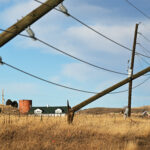Pennsylvania, New York, Delaware and New Jersey have agreed to share the costs of a $500,000 study to examine the effects of operational changes at major reservoirs throughout the entire Delaware River basin.
The state will form a task force through the Delaware River Basin Commission to examine flood mitigation issues along the 330-mile river and its 216 tributaries.
This is in addition to an agreement for an interim spill mitigation program for managing releases from New York City’s reservoirs.
Pennsylvania, New Jersey and New York each will contribute $150,000 toward a study that examines the potential effects of managing reservoirs throughout the basin to reduce flooding on the Delaware River and its tributaries. Delaware will provide $50,000.
The task force will look at storm water management, land-use patterns, open space and farmland preservation, floodplain regulations, and other potential non-structural flood mitigation measures in the basin, which is home to nearly 7.8 million residents, including 5.2 million Pennsylvanians.
All four states are members of the Delaware River Basin Commission, which was created in 1961 as a regional body to manage the river system for multiple purposes, including water supply, pollution control, flood control, watershed management, fish and wildlife management, recreation, power generation and water allocation.
The Delaware River has flooded three times in two years – September 2004, April 2005 and June 2006 – after a period of nearly 50 years without any widespread main stem flooding.
Under the spill mitigation program, New York City will increase releases to the Delaware River from its Neversink, Pepacton and Cannonsville reservoirs between July 1 and March 31, during periods of above-normal hydrologic conditions. The plan provides for greater reserve capacity in the reservoirs during the Atlantic hurricane season.
With a storage void the reservoirs can capture more runoff in the upper reaches of the Delaware River. The spill reduction will not eliminate flooding – the New York City reservoirs control only about one-fifth of the watershed – but flood crests may be reduced immediately below the reservoirs. The plan likely will have little flood mitigation effect farther downstream in Pennsylvania, especially after periods of heavy rains.
“These reservoirs are just one piece of a very large and complex flood protection plan for the basin as a whole,” Pennsylvania Governor Edward G. Rendell said. “Lowering reservoir levels is by no means a silver bullet for addressing flooding along the Delaware River, but it may provide an added measure of protection for downstream communities until a more comprehensive program can be developed and adopted.”
Operations under the interim spill mitigation program, which still requires formal approval by the parties to the 1954 Supreme Court Decree as well as adoption by the DRBC, will be in effect through March 31. DRBC will vote on adoption of the plan Sept. 27. The spill mitigation program is moving forward simultaneously with development of a comprehensive flood mitigation plan.
More than a dozen other reservoirs in the basin, built for purposes other than flood control, may offer opportunities to provide limited additional flood mitigation. Some observers believe that a new model is needed to understand what flood mitigation benefits may be derived from altering the operations at those reservoirs.
The 330-mile Delaware River is the longest undammed river east of the Mississippi, running from Hancock, N.Y., to the mouth of the Delaware Bay where it meets the Atlantic Ocean. Fifteen million people draw water from the Delaware River and its 216 tributaries.
“We won’t ever stop floods from happening, but we can mitigate their impact,” said New Jersey Governor Jon S. Corzine.
Last month, New Jersey announced new flood-control regulations that are among the nation’s strongest for imposing limitations on development in a flood plain and providing stream-corridor protections.
The task force is supposed to present its preliminary recommendations to Governor Corzine, Pennsylvania Gov. Ed Rendell, New York Gov. George Pataki and Delaware Gov. Ruth Ann Minner by the end of the year.
Was this article valuable?
Here are more articles you may enjoy.

 LA Fires Push Insurers’ 2025 Disaster Losses to $107 Billion
LA Fires Push Insurers’ 2025 Disaster Losses to $107 Billion  NYT Asks Judge to Dismiss Trump’s ‘Implausible’ Defamation Suit
NYT Asks Judge to Dismiss Trump’s ‘Implausible’ Defamation Suit  Marijuana’s Move to Schedule III: What it Really Means for Cannabis Insurance
Marijuana’s Move to Schedule III: What it Really Means for Cannabis Insurance  Rare Weather Warning Issued as Strong Gusts Fuel Colorado Wildfire Threats
Rare Weather Warning Issued as Strong Gusts Fuel Colorado Wildfire Threats 